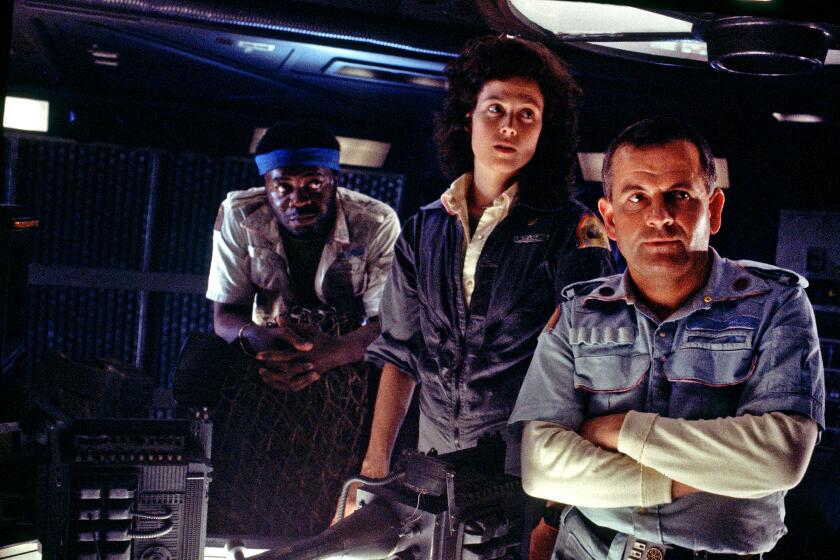MOVIES : COMMENTARY : Raising Kane . . . Over What? : Orson Welles’ ‘Citizen Kane’ returns 50 years after its opening to remind us that it remains the quintessential cinematic experience
The lips, enormous, whisper but a single word, “Rosebud,” then speak no more. The hand, suddenly relaxed, lets a glass snow dome fall unheeded to the floor. A nurse rushes in and suddenly we understand: A life is over, a man is dead.
But not just any man. And, for that matter, not just any film.
Because right from those endlessly celebrated opening moments, “Citizen Kane,” produced, directed, co-written and starring a nervy 25-year-old named Orson Welles, announced itself as a force to be reckoned with.
In the half-century since its May 1, 1941, premiere, “Citizen Kane” has awed, dazzled and bewitched audiences, critics and filmmakers alike. Andrew Sarris called it “the work that influenced the cinema more profoundly than any American film since ‘Birth of a Nation. “ Directors as disparate as Francois Truffaut and Martin Scorsese claimed that Welles’ masterpiece inspired more would-be directors than anything in cinema history, and Sight and Sound magazine’s once-every-decade poll of international critics named it the best film of all time not once but on three occasions, an unprecedented run.
Equally striking, no fewer than four books have been written on its production, including an essay collection, a scholarly examination by Robert Carringer, “The Citizen Kane Book” (which includes the script and Pauline Kael’s explosive defense of co-author Herman J. Mankiewicz) and, most recently and most heavily illustrated, a fact-filled “Fiftieth Anniversary Album” by Harlan Lebo. And now, thanks to Hollywood’s current fascination with restoration and anniversaries, we get the chance to remind ourselves what all this fuss is about.
Starting Wednesday, the 50th anniversary of its premiere, a (what-else-but?) newly restored version of “Citizen Kane” will begin theatrical runs at the Nuart in West Los Angeles and similar houses in eight other cities. Because the “Kane” camera negative was destroyed in a fire in New Jersey during the 1970s, a new one had to be struck from a nitrate print and then tinkered with over the course of four years to the specifications of director Robert Wise, the film’s original editor.
While taking the time and trouble to re-see previously unseen (or at best dimly remembered) classic films may sound about as appealing as curling up with such old high school assignments as “Silas Marner” and “The Mill on the Floss,” no one need feel this way about “Citizen Kane.” It is a great film not for any fusty academic reasons, but precisely because its greatness is breathtakingly accessible, because it is, in critic Kenneth Tynan’s words, “a machine designed to astonish.” And astonish it still does.
It took an extraordinary combination of circumstances for this to happen, starting with Welles’ background and the way he came to Hollywood. A protean prodigy who created a national “the-Martians-have-landed” panic with his inventive broadcast of H.G. Wells’ “The War of the Worlds,” Welles had already made his mark on both radio and theater when RKO, a small but feisty studio eager to increase its prestige, lured him to Hollywood with a contract that gave an absolute beginner an unprecedented amount of control over the final product.
Welles did not come to Hollywood with “Citizen Kane” on his mind; like Francis Coppola several generations later, he had designs on Joseph Conrad’s “Heart of Darkness,” and then thought about adapting a since-forgotten spy novel called “The Smiler With a Knife.”
Then Welles hooked up with screenwriter Mankiewicz, a legendary raconteur and bon vivant, not necessarily in that order. It was Mankiewicz who told a hostess after becoming ill at a tony dinner party, “Don’t worry, the white wine came up with the fish,” and it was he who sent that famous telegram back East to fellow writer Ben Hecht: “Millions are to be grabbed out here and your only competition is idiots. Don’t let this get around.”
Despite the torrent of words that “Citizen Kane” has spawned, it is still unclear exactly which of these two men came up with the idea of doing a film based loosely on newspaper tycoon William Randolph Hearst. One could argue that Mankiewicz was often the guest of Hearst and his mistress, actress Marion Davies, at Hearst Castle, and was in the position to know interesting details (such as the lady’s infatuation with jigsaw puzzles) that eventually made it into the film, but on the other hand he also surely knew that Davies was enormously more talented than “Kane’s” feeble film mistress.
Though Mankiewicz no doubt wrote the initial drafts (while recuperating from an auto accident at Mrs. Campbell’s Guest Ranch in Victorville, 65 miles outside of Los Angeles), Welles, a notorious tinkerer and rewriter, clearly put his stamp on the manuscript as well. Always touchy about his credits, especially after Pauline Kael called his “Kane” co-authorship into dispute, Welles offered Robert Carringer his magisterial final thoughts on the process: Collaborators make contributions, he said from on high, but only a director can make a film.
Whoever did most (and the basic flashback-through-witnesses structure probably derived from yet a third source, an original non-comedic script by Preston Sturges filmed in 1933 as “The Power and the Glory”), the result was a story classic enough to retain its power through numerous re-seeings.
Intent on finding out the real news-behind-the-news of media magnate and kingmaker Charles Foster Kane, and hopeful that his dying word, “Rosebud,” will unlock the puzzle, a reporter interviews the important people in Kane’s life, enabling us to see the man’s story through an intriguing prism of multiple viewpoints.
We see Kane as a young boy, torn from a home he loves because his family comes into sudden wealth. We see him when he starts in newspapers, a kind of Prince Hal full of progressive principles and a becoming modesty. Welles’ casual but finely controlled performance charms the pants off us; we are won over by the man’s ease, his largeness, his willingness to fight for the common man. But, gradually, almost imperceptibly, Kane hardens and turns away from the light, believing that “people will think what I tell them to think,” retreating from a quest for public office and approval to the life of the world’s wealthiest recluse. “He was disappointed in the world,” says old friend Jed Leland (Joseph Cotten), “so he built one of his own.”
Though he was hardly as alienated as his creation when he came to Hollywood, Orson Welles’ success with “Citizen Kane” comes from that same ability to build a world of his own. With all of the established motion-picture acting talent to choose from, he selected either people with minor credits (Dorothy Comingore, who played Susan Foster Kane, was a veteran of “Three Stooges” vehicles) or used actors from the Mercury Theater, his stage and radio ensemble. A full 15 Mercury players appeared in “Kane,” and though not a few--including Joseph Cotten and Agnes Moorehead--ended up with film careers of their own, at this point they were new to the business and owed their primary allegiance to Welles, making them doubly willing to follow his directorial lead.
When it came to the visual side of “Citizen Kane,” Welles built his own world with even more of a vengeance. He and art director Perry Ferguson worked up something like 116 sets, an enormous number, and almost all of them wonderfully detailed. Welles thought so much of Gregg Toland, the genius behind “Kane’s” famous deep-focus photography, which allowed the director to use all of the frame, from extreme close-up to deep background, that he put the cinematographer’s credit on the same title card with his own. Always an inventive cameraman, eager to experiment before and after his experience with Welles, here Toland also had the advantage of improvements in the camera as well as in negative and release-print film stock that were just becoming available.
Working with a crack crew that he knew how to motivate, Welles and his associates were up to any challenge the script demanded. To get parts of the “March of Time” newsreel footage to look appropriately aged, it was dragged across a concrete floor. To get Susan Foster Kane to sound like a failure as an opera star, composer Bernard Herrmann made an otherwise fine singer work above her range. When the scenes of Jed Leland as an old wheelchair-bound man had to be shot before the appropriate sets could be built, discreet rear projection was used to get the same effect. In fact, many of the film’s most celebrated deep-focus shots turn out to be special visual effects cooked up inside the camera.
It is the splendid paradox of “Citizen Kane,” however, that none of this insider stuff, intriguing though it may be, really matters at all. For one thing, film historians tell us that many of the techniques that characterize “Kane” visually, such things as deep-focus photography, long takes, sound montage and the placement of ceilings in the shot, were probably pioneered somewhere else, just as the flashback narrative technique was used first by Sturges.
What makes “Kane” distinctive, however, is the way everything was pulled together. What Welles and his team did was to define the state of film art, encapsulating the kind of excitement that medium and that medium alone can offer while simultaneously pointing toward what was still to come. And they did it with an energy that takes no prisoners, even today. If there was a hallway a character could walk down to make a shot more interesting, down it he or she would inevitably go. If there was a more and a less demanding way to shoot a scene, no one hesitated to do things the hard way. The result was a you-ain’t-seen-nothing-yet exuberance that is so overpowering, so quintessentially cinematic, that the frame can barely contain it.
Ultimately, perhaps, the great joy of “Citizen Kane” lies in the sad fact that a story as complex and psychologically nuanced as the one Mankiewicz and Welles came up with almost never gets this kind of vivid, tour de force visual treatment, and special-effects-heavy films (which “Kane” clearly is) are just about never this intellectually provocative. You don’t need weighty tomes to appreciate “Citizen Kane”; you don’t have to nod with half-hearted sagacity and say, “Yes, I can see how it works.” Watching it leaves you absolutely no choice: You can’t focus your eyes on the screen without being caught up in exactly the same sweep of emotions viewers felt when it was premiered half a century ago. If ever a film projects absolutely all the excitement inherent in every aspect of this often frustrating medium, this is the one that does.
More to Read
Only good movies
Get the Indie Focus newsletter, Mark Olsen's weekly guide to the world of cinema.
You may occasionally receive promotional content from the Los Angeles Times.











